
Nord-du-Québec is the largest, but the least populous, of the seventeen administrative regions of Quebec, Canada. With nearly 750,000 square kilometres (290,000 sq mi) of land area, and very extensive lakes and rivers, it covers much of the Labrador Peninsula and about 55% of the total land surface area of Quebec, while containing a little more than 0.5% of the population.

Hydro-Québec is a public utility that manages the generation, transmission and distribution of electricity in the Canadian province of Quebec, as well as the export of power to portions of the Northeast United States.
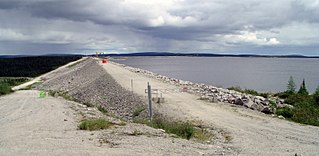
Caniapiscau is a vast unorganized territory in the Côte-Nord region of Quebec, Canada, part of Caniapiscau Regional County Municipality.

The Société d'énergie de la Baie James is the company in charge of building the hydroelectric development known as the James Bay Project in northern Quebec. It was established in December 1971 by the Société de développement de la Baie James (SDBJ), a Crown corporation of the province of Quebec and became a wholly owned subsididiary of Hydro-Québec in 1978.

The James Bay Project refers to the construction of a series of hydroelectric power stations on the La Grande River in northwestern Quebec, Canada by state-owned utility Hydro-Québec, and the diversion of neighbouring rivers into the La Grande watershed. It is located between James Bay to the west and Labrador to the east, and its waters flow from the Laurentian Plateau of the Canadian Shield. The project covers an area the size of New York State and is one of the largest hydroelectric systems in the world. It has cost upwards of US$20 billion to build and has an installed generating capacity of 16,527 megawatts. If fully expanded to include all of the original planned dams, as well as the additional James Bay II projects, the system would generate a total of 27,000 MW, making it the largest hydroelectric system in the world. It has been built since 1974 by James Bay Energy (SDBJ) for Hydro-Québec.

The Rupert River is one of the largest rivers in Quebec, Canada. From its headwaters in Lake Mistassini, the largest natural lake in Quebec, it flows 556 kilometres (345 mi) west into Rupert Bay on James Bay. The Rupert drains an area of 43,400 square kilometres (16,800 sq mi).
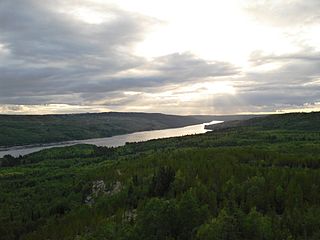
La Grande River is a river in northwestern Quebec, Canada, which rises in the highlands of north central Quebec and flows roughly 900 km (560 mi) west to drain into James Bay. It is the second largest river in Quebec, surpassed only by the Saint Lawrence River.
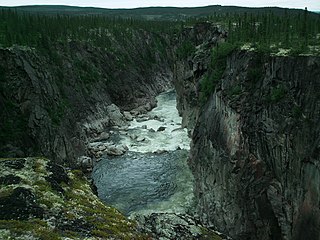
The Caniapiscau River is a tributary of the Koksoak River in Nunavik, Quebec, Canada. In Cree the name of the river means rocky point.

The Caniapiscau Reservoir is a reservoir on the upper Caniapiscau River in the Côte-Nord administrative region of the Canadian province of Quebec. It is the largest body of water in Quebec and the second largest reservoir in Canada.

Matagami is a small town in Quebec, Canada. It is located north of Amos, on Matagami Lake, at the northern terminus of Route 109 and the start of the James Bay Road. It is enclaved within the local municipality of Eeyou Istchee James Bay Regional Government, but administratively independent of it. The town had a population of 1,526 as of the Canada 2011 Census.

Chisasibi is a village on the eastern shore of James Bay, in the Eeyou Istchee equivalent territory (ET) in northern Quebec, Canada. It is situated on the south shore of La Grande River, less than 10 km (6.2 mi) from the river's mouth. Chisasibi is one of nine Cree villages in the region, and is a member of the Grand Council of the Crees of Quebec. The territory surrounding Chisasibi is part of the Eeyou Istchee James Bay Territory, of which parts are jointly managed by the municipalities of the Jamésie TE and the Cree Regional Authority of the Eeyou Istchee TE.

The Municipality of Baie-James was a municipality in northern Quebec, Canada, which existed from 1971 to 2012. Located to the east of James Bay, Baie-James covered 297,332.84 km2 (114,800.85 sq mi) of land, making it the largest incorporated municipality in Canada — only eight unorganized territories were larger. Its territory almost entirely covered the administrative region of Jamésie, although it contained less than five percent of the population. Essentially, it was the remainder of the Jamésie Territory's land after all of the major population centres were removed.
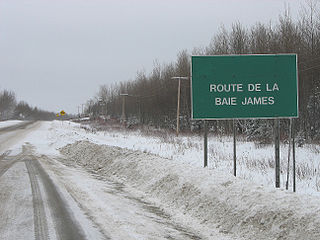
The James Bay Road, officially the Route Billy-Diamond Highway, is a remote wilderness highway winding its way through the Canadian Shield in northwestern Quebec and reaches into the James Bay region. It starts in Matagami as an extension of Route 109 and ends at Radisson. The road is fully paved, well maintained, and plowed during the winter. It was originally constructed to carry loads of 300 tons, and has mostly gentle curves and hills with wide shoulders. The road is maintained by the Eeyou Istchee James Bay Regional Government. Connecting to other routes such as the Trans-Taiga Road and the Route du Nord, the highway draws tourists interested in reaching the remote wilderness surrounding James Bay, part of Hudson Bay.

The Trans-Taiga Road is an extremely remote wilderness road in northern Quebec, Canada. It is 582 kilometres (362 mi) long to Centrale Brisay and another 84 kilometres (52 mi) along the Caniapiscau Reservoir, all of it unpaved.
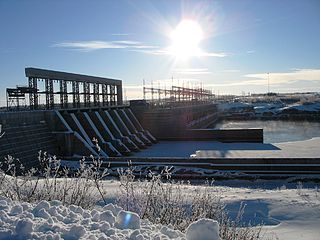
The La Grande-1 (LG-1) is a hydroelectric power station on the La Grande River that is part of Hydro-Québec's James Bay Project. The station can generate 1,436 MW and was commissioned in 1994–1995. A run of the river generating station, it is one of only two generating stations of the James Bay Project that use a reservoir without any major water-level fluctuations. Thus, the amount of electricity generated by the station depends almost entirely on the water-flow of the river, which is largely controlled by upstream reservoirs and generating stations.

The Robert-Bourassa generating station, formerly known as La Grande-2 (LG-2), is a hydroelectric power station on the La Grande River that is part of Hydro-Québec's James Bay Project in Canada. The station can generate 5,616 MW and its 16 units were gradually commissioned between 1979 and 1981. Annual generation is in the vicinity of 26500 GWh.

The Great Whale River is a river in Nunavik, Quebec, Canada. It flows from Lac Saint-Luson through Lac Bienville west to Hudson Bay. While lower section of the river has very powerful current, with many waterfalls and rapids, upper section consists of series of lakes interconnected by steep rapids and ledges.
Robert A. Boyd was a Canadian electric engineer and utility executive. He successfully led the construction of the first phase of the James Bay hydroelectric project, a large dam complex built in northern Quebec by Hydro-Québec during the 1970s and early 1980s.
Hydro-Québec is a government-owned public utility established in 1944 by the Government of Quebec. The company is in charge of the generation, transmission and distribution of electricity across Quebec. Its head office is located in Montreal.
Eeyou Istchee James Bay Regional Government is a local municipality in the Jamésie (TE) in administrative region of Nord-du-Québec.


















